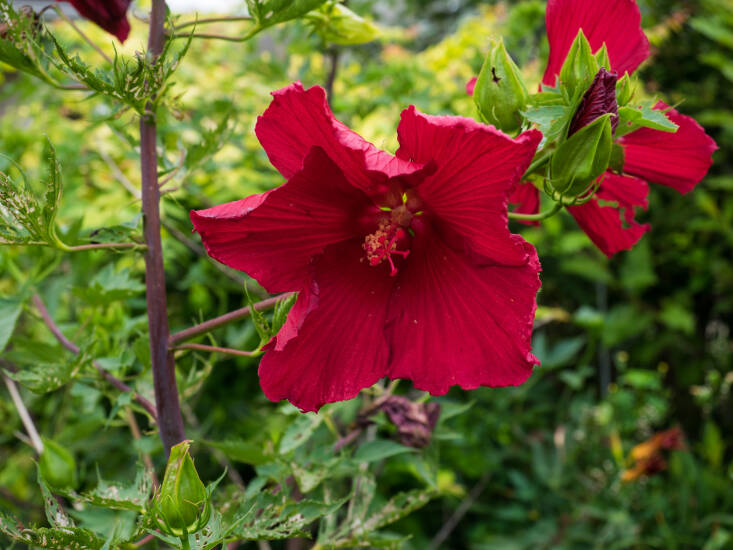Hibiscus, Hibiscus
Recently I was looking for a plant to add to my client’s garden that screamed big, exotic flowers. What came to mind, of course, was a Hibiscus. And not the tropical sensitive kind that only survives when pampered indoors or planted outside in balmy Hawaii or Miami. I wanted a hardy Hibiscus. Yes, there are actually two types. In fact, breeders for over a 100 years have been working on increasing the varieties of hardy ones available to gardeners who are looking to add more flower power to their gardens.
Please keep reading to learn more about hardy Hibiscus:

Let’s clear up the confusion first. The famed frost-tender tropical cultivars come from H. rosa-sinensis, but the hardier type (surviving in USDA Zones 4-9, and some up to Zone 11) comes from a cornucopia of different Hibiscuses. When you find one in the nursery, the label might say Hibiscus x or just Hibiscus hybrid which obscures it genetic origin, but either way, hardy Hibiscus can be found in a variety of colors and sizes, raging from 2-inch cuties to 10-inch shrubs, all with the same growing needs.
Did you know that each individual Hibiscus flower only blooms for one day, just like the daylily? But don’t despair, more flowers will open in succession. And you can encourage a longer bloom by deadheading spent flowers. To see serious growth and blooms, you may need to be patient and wait until the weather warms up—some start in June but most in August—and then you will be rewarded all the way until the first frost.
To ensure a happy Hibiscus, there are some key points to remember. To start with, these plants love the sun, soil that drains, and to be well-watered. If you provide these necessities, then your plant will have larger flowers and lusher foliage. Remember when planting your Hibiscus to make sure the crown of the pant rests just at or above the soil surface and to get your plant in the ground after the threat of frost has passed but before the heat of summer ramps up. Then before winter comes, apply a good layer of mulch around the base to keep roots toasty warm. Pro Tip: Prune old stems down to 8 inches or so before new stems emerge in the spring. Then when the plant gets going, you can trim it to shape if needed.
Cheat Sheet

- Position taller varieties in the back of a perennial bed for a dramatic late season show and shorter ones as focal plants in pots on your sunny patio or porch.
- Hardy Hibiscus looks at home in tropical, Moroccan, or cottage style gardens.
- Pollinators, such as bees and hummingbirds, will definitely visit to romance the blooms.
- You might be wondering if this is the plant that you can harvest and make red-hued tasty tea. Unfortunately, it is not. You are looking for Hibiscus sabdariffa, commonly called Rosella.
Keep It Alive

- Plant your hardy Hibiscus in a warm sunny spot with at least 6 hours of sun. Less sun means fewer flowers and more straggly growth. In cooler climates, plant your shrub near a south-facing wall or in an area protected from damaging winds.
- These plants like rich, moist, slightly acidic soil and if not well-watered, they will drop their leaves and look like a bunch of toothpicks. But don’t worry, the plant will normally bounce back with regular watering.
- Hardy Hibiscus can be a heavy feeder; a generous layer of compost around the base of the plant in the spring is perfect.
- If you want to propagate your plant, take a softwood cutting in the spring or early summer.
- Watch out for pesky aphids, white flies, and black scale. To avoid fungal diseases, avoid splashing water on the leaves.
For more flower power, see:












Have a Question or Comment About This Post?
Join the conversation (0)